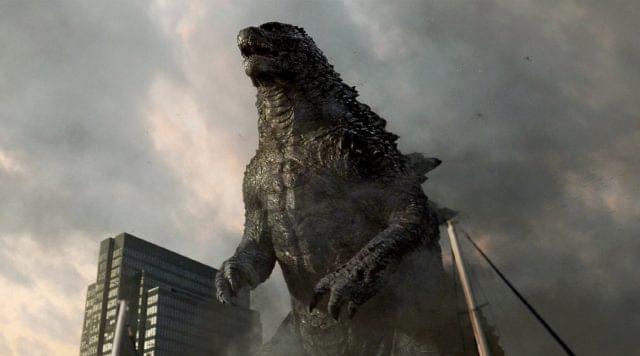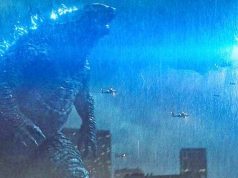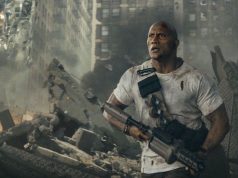
The day has come! After 60 years, for the first time, we’ve finally got a Hollywood version of Godzilla. It’s amazing nobody ever tried it before, but better late than never, right? Finally! The first American Godzilla movie.
You heard me. THE FIRST.
“Godzilla,” directed by Gareth Edwards from a sturdy if mechanical screenplay by Max Borenstein, reboots the venerable Japanese monster for the 21st century while staying true to its roots as a fearsome dino-beast that is both a threat to and a savior of mankind. Edwards and Borenstein treat the matter seriously, without a lot of jokiness or meta-references, and the businesslike attitude pays off in a movie that’s serious about being tremendous fun. This is no expensive lark tossed off by goofballs working for paychecks. This is Godzilla, made by a director who wanted to get it right.
Starting with appetite-whetting sequences in which huge, mysterious clues are discovered and strange, unexplainable earth tremors recorded, the film follows a straightforward path through the usual tropes: a young Navy man named Ford Brody (Aaron Taylor-Johnson) happens to be where the action is; he’s separated from his worried wife (Elizabeth Olsen) and son; a couple of scientists (Ken Watanabe, Sally Hawkins) tell the military how to combat the “massive unidentified terrestrial organism” when it emerges; many objects are crushed and smashed and knocked down and set on fire. People gaze upward in wonder and astonishment (the “Spielberg face”) when they’re not fleeing in terror. It’s a familiar routine, but Edwards takes us through it gracefully. And to tide us over until the title character arrives, Edwards gives us a non-Godzilla monster as an appetizer, a giant flying insectoid thing that lives on radiation.
Impressively, this is only Edwards’ second feature. His first, a low-budget indie called “Monsters” (2010), was also about giant creatures, but it focused on two characters trekking through a monster-infested area, and it ingeniously (and inexpensively) did not emphasize the beasts themselves.
You can see Edwards leaning that way in “Godzilla,” too. Even though he has the budget to create a wall-to-wall spectacle, he’s still interested in the human point of view. And so we often see the monsters the way the people are seeing them: through shattered glass, from behind a barricade, in TV news coverage, and so on. Edwards teases us the way Spielberg did in “Jaws” and “Jurassic Park” (though not quite to such great effect), waiting till the second half to fully reveal the awesome majesty of full-frontal Godzilla.
Paradoxically, though Edwards wants to focus on the humans, he cast a dull human as his lead character. That’s Aaron Taylor-Johnson (“Kick-Ass”), from the current line of generically handsome but emotionally stagnant action stars (see also: Charlie Hunnam in “Pacific Rim,” Kellan Lutz in “The Legend of Hercules,” Paul Walker in everything). Don’t be misled by the presence of Bryan Cranston, Juliette Binoche, Ken Watanabe, Sally Hawkins, Elizabeth Olsen, and David Strathairn in the cast. Their screen time ranges from “sufficient” to “egregiously short” (and the female characters have precious little to do, story-wise), and ATJ is in almost every scene, fulfilling his basic responsibilities without engaging us.
The script doesn’t do him any favors, making Ford Brody less a character than a series of heroic plot points. I note that when it isn’t geographically feasible for Brody to rescue his own son from anything, the movie gives him a random lost little boy to protect for a few scenes, just to make sure that box gets checked off.
For me, Edwards’ way of building anticipation sometimes borders on frustration, especially when major monster-on-monster action is about to happen and Edwards cuts away. At the risk of sounding like one of those “SHOW US THE MONSTER IMMEDIATELY AND ALWAYS!” short-attention-span types … come on. There’s teasing, and there’s cruelty.
That being said, once things do kick into high gear, they kick hard. Despite their digital nature, Godzilla and the other gargantuan things feel like they have weight and mass, and the wounds they inflict on each other and their surroundings are solid. The action is always clear and logical (and cinematographer Seamus McGarvey’s work is beautiful), culminating in a final battle that rewards our patience. Earlier frustrations tend to be forgiven once you do finally get what you came for. And hey, now we have an American Godzilla to play with! For the first time.
B (2 hrs., 3 min.; )





